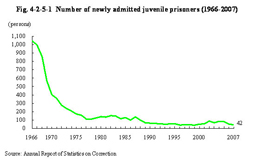| Previous Next Index Image Index Year Selection | |
|
|
1 Number and characteristics of juvenile prisoners Fig.4–2–5–1 shows the trends in the number of newly admitted juvenile prisoners since 1966. Fig. 4-2-5-1 Number of newly admitted juvenile prisoners (1966–2007) Among juvenile prisoners newly admitted in 2007 (those who were over 20 at the time of admittance but were 19 when receiving an indeterminate sentence are considered to be 19), three juveniles were aged 16 or 17 and 39 juveniles were aged 18 or 19. After the amendment of the Juvenile Act in 2000, there were no juvenile prisoners under 16 at the time of admittance between 2001 and 2007.Among newly admitted juvenile prisoners in 2007, by length of sentence term (for those sentenced to imprisonment for indeterminate terms, by length of the maximum term), none was sentenced to life imprisonment, one to imprisonment for a term over 10 years but 15 years or less, 14 to imprisonment for terms over five years but 10 years or less, 14 to imprisonment for terms over three years but five years or less, and 13 to imprisonment for three years or less. By type of sentence, 40 were sentenced to imprisonment with work and two were sentenced to imprisonment without work. By type of offense, robbery was largest in number with 10 (two for robbery, six for robbery causing death or injury, and two for rape at the scene of a robbery/rape at the scene of a robbery causing death), followed by injury with eight (three for injury and five for injury causing death), negligence in vehicle driving/negligence in the pursuit of social activities with seven, and rape/rape causing death or injury with four, theft with four, homicide with three, and Stimulants Control Act violations with three (Source: Annual Report of Statistics on Correction). |
